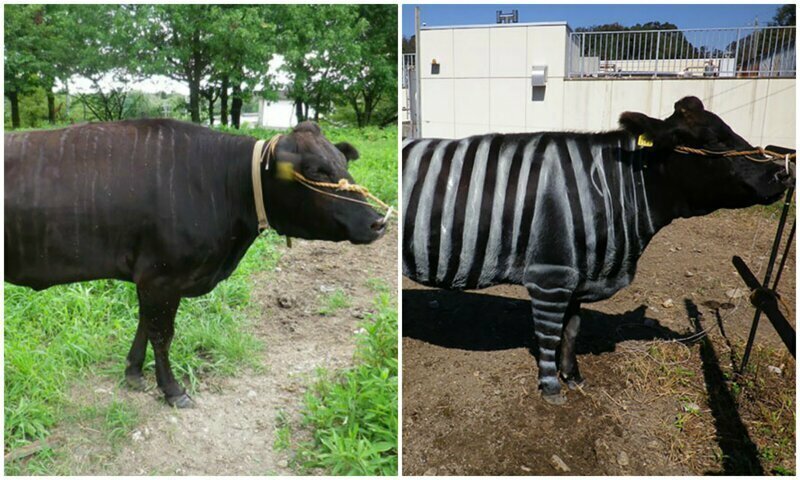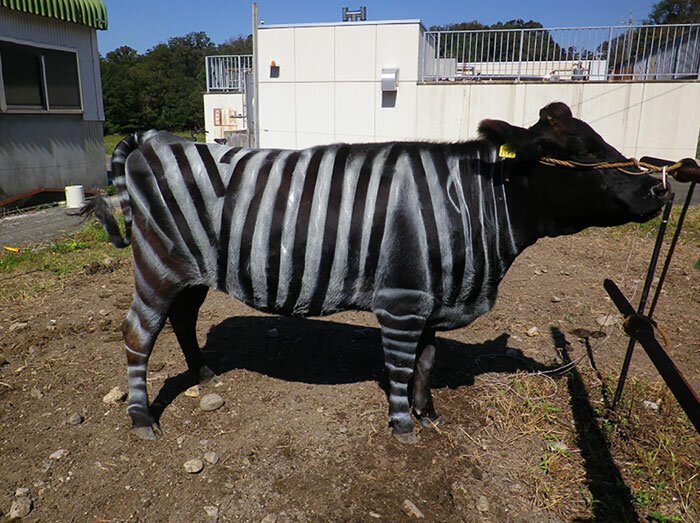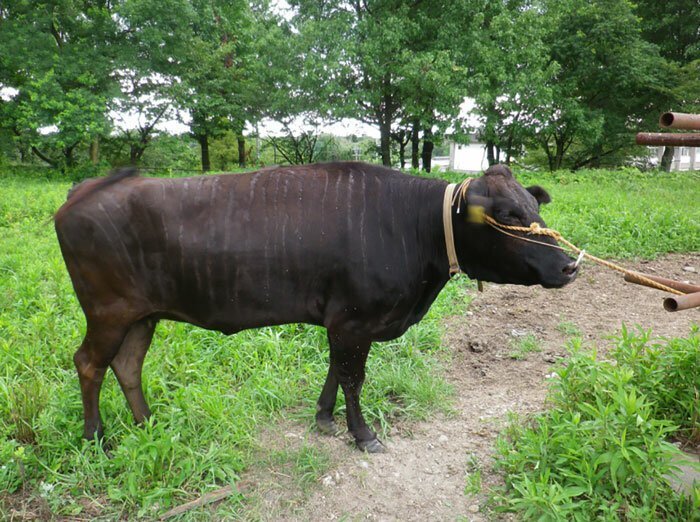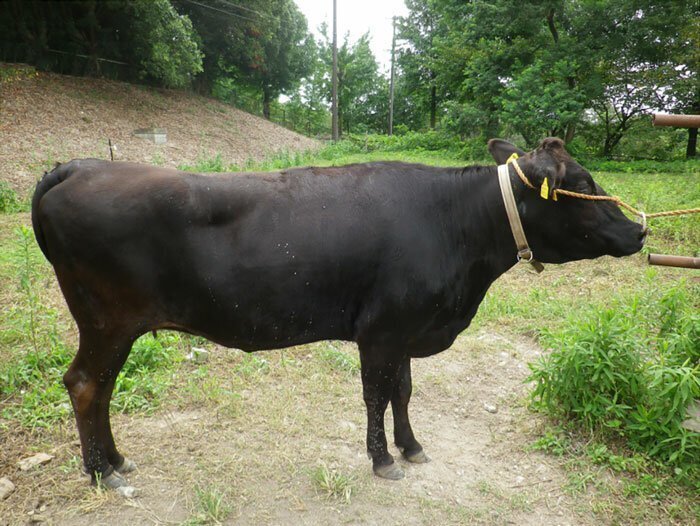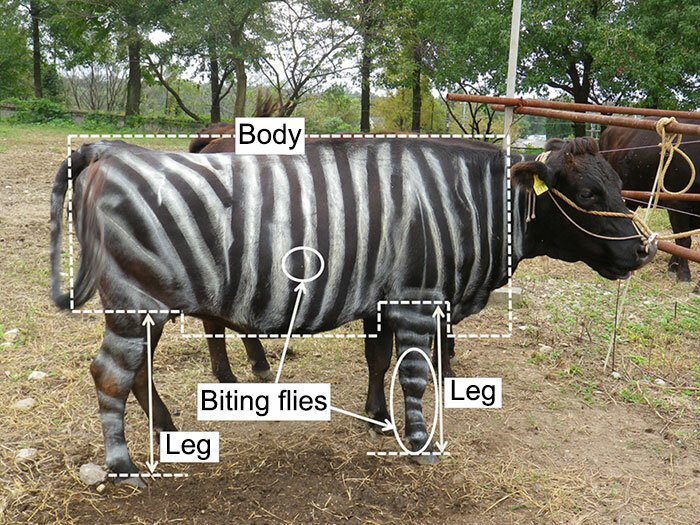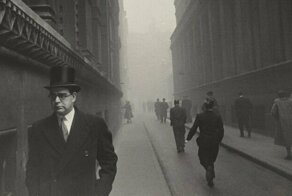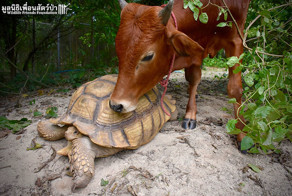0
5
Scientists conducted a study showing that there’s a far better way to protect cows from pesky biting flies than using pesticides. That method involves painting the cows with zebra-like stripes, which help camouflage the animals from annoying pests.
a.
Researchers tested their theories on 6 Japanese Black cows by either painting zebra-like stripes (black-and-white, see cow ‘a’), painting only black stripes (cow ‘b’) or leaving the dark fur unpainted (cow ‘c’). By liberally applying paint, scientists have effectively created a temporary zebra-cow hybrid (a zow or a cowbra if you’ll permit me) that lives a far happier life thanks to not being bitten countless times each day. The cows are happy. The farmers are happy. And the flies are miserable. It’s _mootastic_ all ‘round.
b.
c.
According to the Japanese researchers who conducted the striped-cow study, their findings are important because they show that pesticides are not as effective at keeping away pests as painting stripes on cows’ fur with non-toxic materials. It’s cheaper. It’s healthier. It’s environmentally friendly. What’s not to like?
Scientists recorded how often the moo-moos would repel biting flies and determined that zebra-stripes “significantly” lowered the number of pest attacks. Thus, we have available an alternate way of protecting our bovine buddies from aggressive flies that doesn’t require spraying everything in sight with pesticides.
Bored Panda interviewed Tomoki Kojima from the Animal Husbandry Division at the Aichi Agricultural Research Center, who was responsible for the study’s conceptualization, data curation, formal analysis, methodology, as well as writing the original draft.
According to the scientist, the biggest challenge related to the study was the co-workers’ response to the idea of painting zebra-like stripes on cows: “They thought I told a joke.”
Scientists recorded how often the moo-moos would repel biting flies and determined that zebra-stripes “significantly” lowered the number of pest attacks. Thus, we have available an alternate way of protecting our bovine buddies from aggressive flies that doesn’t require spraying everything in sight with pesticides.
Bored Panda interviewed Tomoki Kojima from the Animal Husbandry Division at the Aichi Agricultural Research Center, who was responsible for the study’s conceptualization, data curation, formal analysis, methodology, as well as writing the original draft.
According to the scientist, the biggest challenge related to the study was the co-workers’ response to the idea of painting zebra-like stripes on cows: “They thought I told a joke.”
Scientists painted Japanese Black cows with black-and-white stripes to make them look like zebras
“As a researcher of animal husbandry, I hope that the method will be used by farmers and lead to contribute to improving their productivity,” Kojima said.
The researcher also revealed to Bored Panda the inspiration for the study: “About 5 years ago, I watched a Japanese TV program which introduced the function of zebra stripes. I had never known it [before]. After watching the TV program, I looked for and read papers regarding the function of zebra stripes and [I decided that] I would like to apply the function to cows.”
“As we mentioned in our paper, we will start to develop more effective techniques to make cows’ body surface black-and white stripes more easily and to ensure the persistence of black-and-white stripes on livestock during the biting fly season (3-4 months), in order to apply this method to animal production sites.”
Kojima also hinted at future research: “Firstly, I want to apply the method to swine. In addition, a previous study reported spotty coat (diameter is smaller than approximately 10 cm) also has the same effect as zebra stripes, therefore, I want to investigate the effect using Holstein cows painted small spots.”
The researcher also revealed to Bored Panda the inspiration for the study: “About 5 years ago, I watched a Japanese TV program which introduced the function of zebra stripes. I had never known it [before]. After watching the TV program, I looked for and read papers regarding the function of zebra stripes and [I decided that] I would like to apply the function to cows.”
“As we mentioned in our paper, we will start to develop more effective techniques to make cows’ body surface black-and white stripes more easily and to ensure the persistence of black-and-white stripes on livestock during the biting fly season (3-4 months), in order to apply this method to animal production sites.”
Kojima also hinted at future research: “Firstly, I want to apply the method to swine. In addition, a previous study reported spotty coat (diameter is smaller than approximately 10 cm) also has the same effect as zebra stripes, therefore, I want to investigate the effect using Holstein cows painted small spots.”
Source:
Ссылки по теме:
- Scientists Discovered a New cat-fox Species Which Was Previously Believed To Be a Myth
- Giant Tortoise And Baby Cow Who Lost Its Leg Become Best Friends
- 21 Creepy Black and White Photos That Will Give You Nightmares
- There Is An Island That Nobody Can Enter And It Didn’t Exist Until 1963
- Extraordinary Black And White Photographs Of London In The Early 1950s


